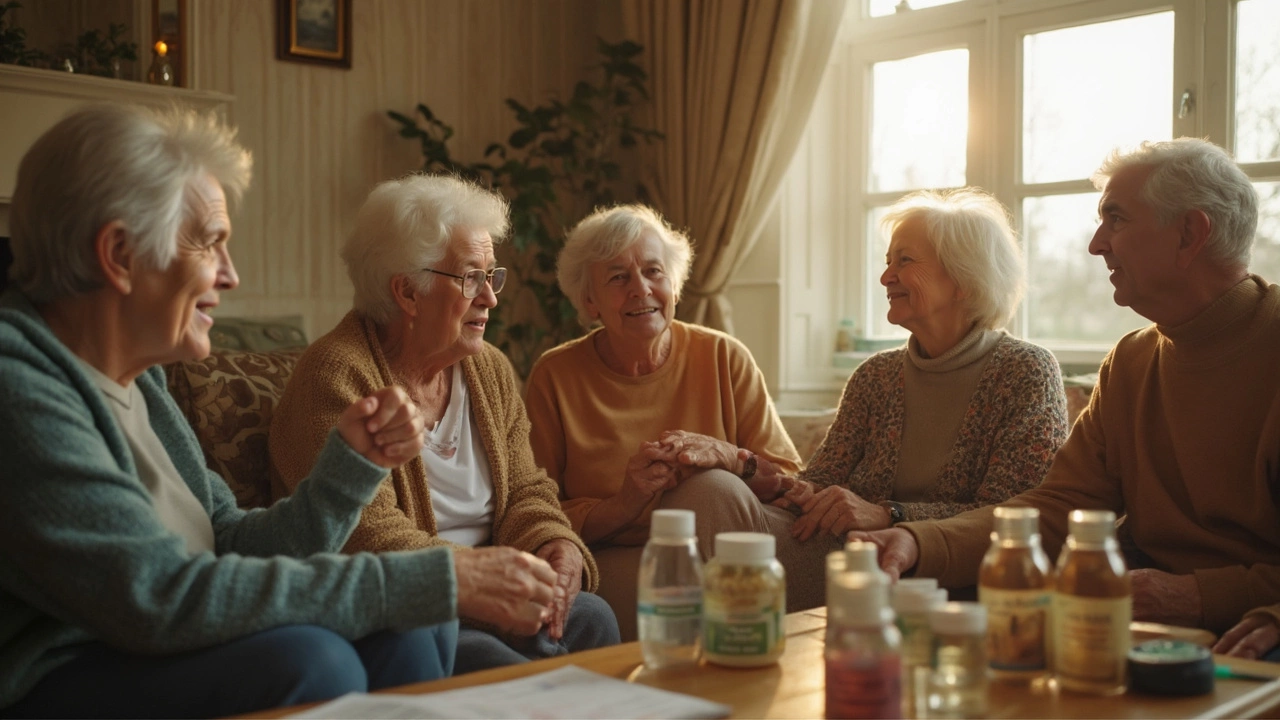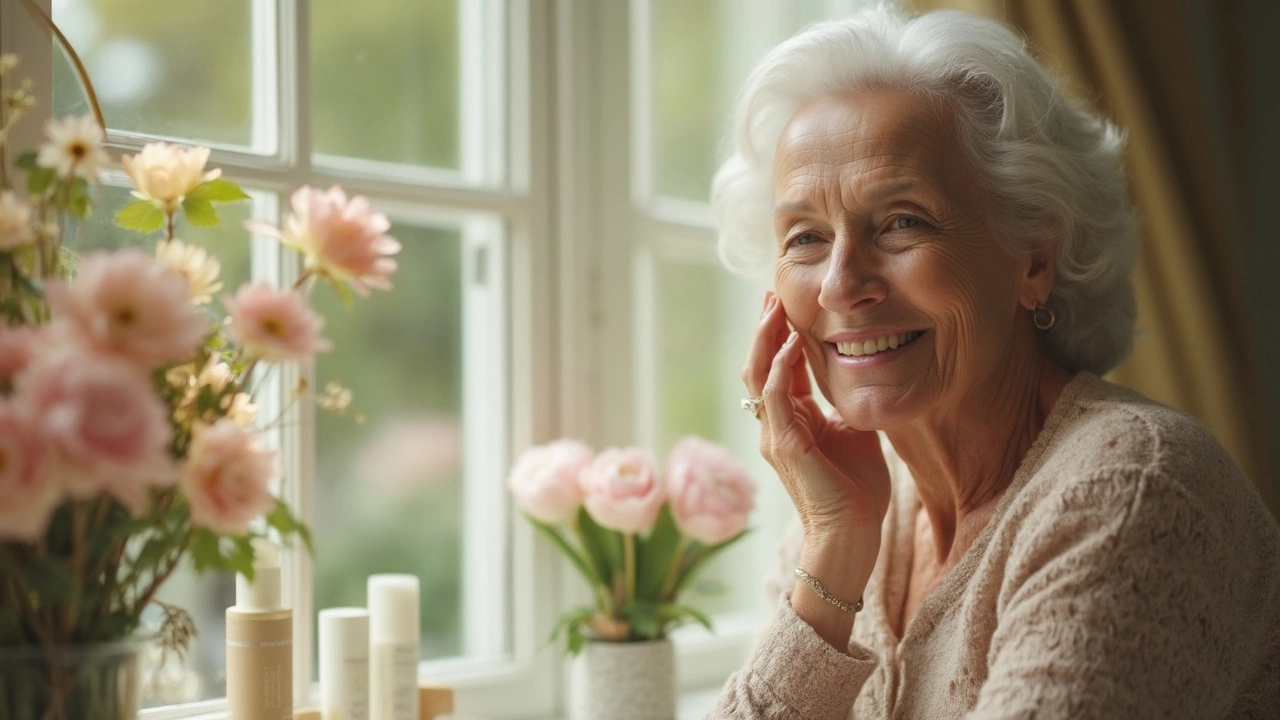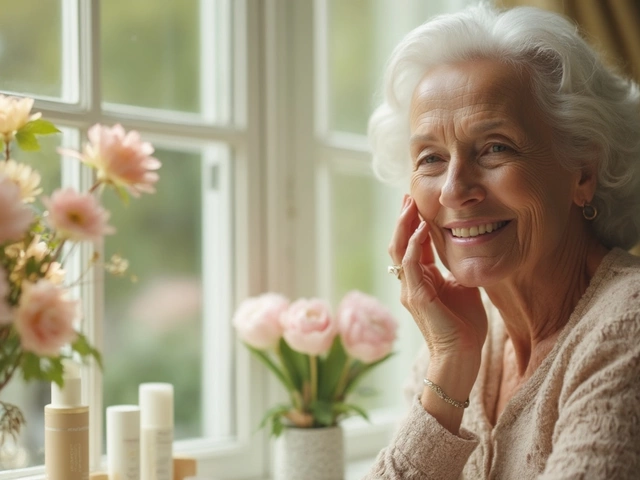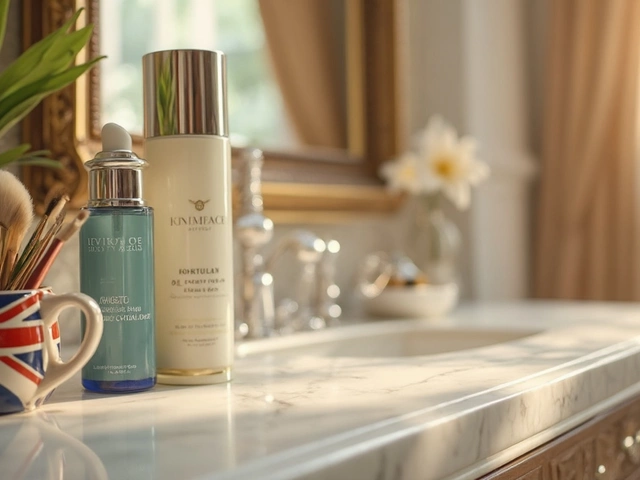Turn seventy and suddenly you realize that your face has its own opinion about everything—from climate to night creams. Moisturizing isn't just a nice idea anymore; it's survival for your skin. Collagen loss, deeper lines, age spots—there's a reason your face feels different than it did at fifty.
If you’re standing in the skincare aisle stuck between 'ultra-firming' serums and 'youth-boosting' masks, you’re not alone. Not all treatments are created equal, especially for skin that’s seen a few more birthdays. Dermatologists actually prefer you skip aggressive peels or harsh exfoliants now. Your skin just can’t handle that level of irritation, and you’ll bounce back slower than you used to.
What’s better? Focus on everything hydrating. Look for products with glycerin, hyaluronic acid, and gentle ceramides. Put down the rough scrubs and try a creamy cleanser instead. Even prescription retinoids (yes, they really work, but use the gentlest kind) can still help, just go slow and buffer with moisturizer to avoid flaking. You’d be shocked how much better skin looks when you simply keep it calm and moisturized—turns out, glow beats tightness at this age.
- What Happens to 70 Year Old Skin?
- Top Professional Treatments Worth Considering
- Home Skincare That Actually Works
- Must-Know Tips for Healthier Looking Skin
What Happens to 70 Year Old Skin?
By the time you hit seventy, your skin has pretty much seen it all. Natural changes stack up fast. The body just doesn't crank out collagen and elastin like it once did, which means your skin gets thinner, saggier, and loses that bounce-back quality. Wrinkles dig in deeper, especially around the eyes, mouth, and jawline. Your complexion might seem dull or uneven no matter how much you moisturize.
Here’s a quick look at the main changes you’re likely dealing with:
- Loss of firmness: Collagen drops by about 1% every year after your 20s, so by 70, your skin can't hold tight like it used to.
- Dryness: Oil glands slow down, so the skin feels parched and sometimes itchy. This makes hydration more important than ever.
- Deeper lines and wrinkles: Fine lines turn into grooves, especially if you've had a lot of sun over the years.
- Age spots and pigmentation: Sun damage from decades ago loves to show up now as brown spots and uneven tone.
- Thinning: The skin's outer layer gets thinner and bruises more easily. If you notice your skin tears more, you’re not imagining it.
A recent dermatology study compared the skin of women aged 30 versus 70 and found:
| Age Group | Collagen in Skin (%) | Skin Hydration (units) |
|---|---|---|
| 30 Years Old | 100 | 50 |
| 70 Years Old | 60 | 30 |
So what does this really mean? Expect your face to react differently to skincare and weather. Hydration and gentle handling move right to the top of your priority list. Forget those peels you saw on social—your skin wants TLC, not drama. If your face feels more sensitive now, that’s just part of the mix.
Top Professional Treatments Worth Considering
If you want real changes for 70 year old skin, drugstore creams only go so far. Sometimes you need help from the pros—think dermatologists or licensed estheticians. But not just any treatment works for mature faces. Certain options have a track record for safety and results in older skin.
Hydrafacial is totally worth asking about. It gives tired skin a serious hydration boost and gently cleans out pores without harsh scrubbing. There’s no downtime—you walk out looking fresher right away. For older skin, that instant glow is huge.
If you’re bothered by deep lines or sagging, ask your dermatologist about micro-needling with platelet-rich plasma (PRP). This sounds high-tech but basically, it encourages your skin to repair itself. Results show up over time, and the main risks are mild redness for a few days. Research shows it really does ramp up collagen in older faces, and isn’t nearly as intense as older laser resurfacing.
Another expert pick? LED light therapy. It’s painless and can be done right after a facial. Red LED light in particular helps boost collagen and calm inflammation. Some people see results in a month or two with regular sessions, especially if dryness and redness are your main issues.
For thinning or patchy dark spots, some dermatologists still recommend low-intensity chemical peels—but nothing extreme. Light peels with alpha hydroxy acids can help fade discoloration and freshen up your complexion. Just expect to repeat this a few times for the best effect and always ask if it’s right for your skin type first.
According to Dr. Leslie Baumann, a board-certified dermatologist, these treatments are safest when the plan is personalized:
"With aging skin, less is sometimes more. You want gentle procedures that hydrate and encourage natural repair, not over-the-top peels or aggressive lasers."
Here’s a quick look at some go-to treatments for mature skin, how long they take, and what to expect for downtime:
| Treatment | Session Length | Downtime |
|---|---|---|
| Hydrafacial | 30-45 min | None |
| Microneedling (with PRP) | 60-90 min | 1-3 days mild redness |
| LED Light Therapy | 20-30 min | None |
| Light Chemical Peel | 30 min | 2-5 days mild flaking |
Always check with a qualified pro before jumping in. And skip anything that sounds too harsh—you want to help your skin, not shock it. Aim for treatments that emphasize hydration, renew, and support your skin’s natural repair methods for the best results.

Home Skincare That Actually Works
Trying to treat 70 year old skin on your face at home doesn't mean breaking the bank. The trick is to work with, not against, your skin’s natural changes. As our skin ages, it gets thinner and holds less moisture, so the focus needs to be on gentle care and deep hydration—not on stripping agents or overdoing anything.
Start with a creamy, mild cleanser. Anything foaming or “deep cleaning” is probably too much at this age. Look for cleansers labeled “hydrating” or “gentle,” with ingredients like ceramides, glycerin, or squalane. This helps avoid dryness right from the start.
Moisturizing isn’t just a step, it’s the main event. Go for a rich moisturizer, and make sure hyaluronic acid or glycerin is high on the ingredient list. These pull water into your skin, making it look plumper. For extra oomph, pat on a serum with hyaluronic acid under your cream.
If you want to use a retinoid (the gold standard for anti-aging), choose retinol or retinaldehyde in low doses. Use it every other night, and always follow with moisturizer. It helps smooth lines, but less is more—if your skin gets flaky or red, cut back.
And don’t skip sunscreen, even if you're mostly indoors. UVA rays still sneak in through windows and speed up aging. Go for a broad-spectrum SPF 30 or higher. Many day creams for mature skin now have SPF included for convenience.
Eye creams really do help with puffiness and dark circles mostly when they’re packed with peptides or caffeine. But if you’re working with a tight budget, your regular face moisturizer is usually fine around the eyes—just apply carefully.
Here are simple, science-backed tips for a daily routine:
- Cleanser: Creamy, gentle formula without alcohols or sulfates.
- Moisturizer: Thick cream with hyaluronic acid, glycerin, or ceramides.
- Serum: Hyaluronic acid or peptides, applied before moisturizer for a boost.
- Retinoid (optional): Low dose, two to three nights a week if your skin tolerates it.
- Sunscreen: Broad-spectrum, SPF 30 or higher, every single day.
- Occasional mask: Hydrating, not clay-based. Look for “soothing” or “moisturizing” on the label.
Ever wonder what goes in the best products for aging skin? Take a look at a few ingredients that make a real difference:
| Ingredient | Why it matters |
|---|---|
| Hyaluronic Acid | Deeply hydrates and plumps up fine lines |
| Glycerin | Attracts water to help smooth dry patches |
| Ceramides | Repair the skin barrier and lock in moisture |
| Peptides | Support collagen and help firm the skin |
| Retinol | Encourages fresh cell growth and fades age spots |
Skip anything labeled for "acne" or "oil control" and avoid rough scrubs. Less is more. Stick to a basic, effective routine and your face will thank you. If a product burns or stings, ditch it—skin at this age just wants to be treated gently.
Must-Know Tips for Healthier Looking Skin
Healthy, glowing skin at seventy isn’t about chasing some magic in a bottle. It’s all about the right habits and products. Here’s what really helps when it comes to best treatment for 70 year old skin on the face:
- Moisturize—seriously, every day. Go for rich creams with ceramides or hyaluronic acid. Dryness is enemy number one for older skin.
- Always use sunscreen. Even if you’re mostly indoors, daily SPF 30 or higher protects from sneaky window UV rays and helps prevent new spots and wrinkles.
- Gentle cleansers, not soap. Harsh soaps strip natural oils. Cream or oil-based cleansers do the job without leaving your skin tight.
- Skip the scrubs. Physical and gritty exfoliants can tear fragile skin. If you want some exfoliation, a mild lactic acid serum once or twice a week works safely.
- See a dermatologist yearly. They can spot trouble early—like precancerous spots—and tweak your routine if you see sudden changes in skin texture, color, or new growths.
- Hydration matters inside out. Water isn't a cure-all, but staying well hydrated does keep lines softer and your skin plumper.
If you’re curious how much hydration matters, there’s a clear link: in a real-world study, postmenopausal women who amped up their water saw improved skin elasticity after two months.
| Tip | Impact |
|---|---|
| Daily moisturizer | Reduces appearance of fine lines and prevents dryness |
| SPF 30+ every morning | Protects against dark spots, wrinkles, and skin cancer |
| Mild exfoliation (max 2x/week) | Improved glow, smoother skin texture |
Little things make a big difference—like switching to satin pillowcases to cut down on sleep creases, or running a humidifier at night, especially in winter. And seriously, don’t underestimate how much a balanced diet with enough healthy fats helps your skin bounce back. Try avocado, olive oil, or a handful of nuts.


